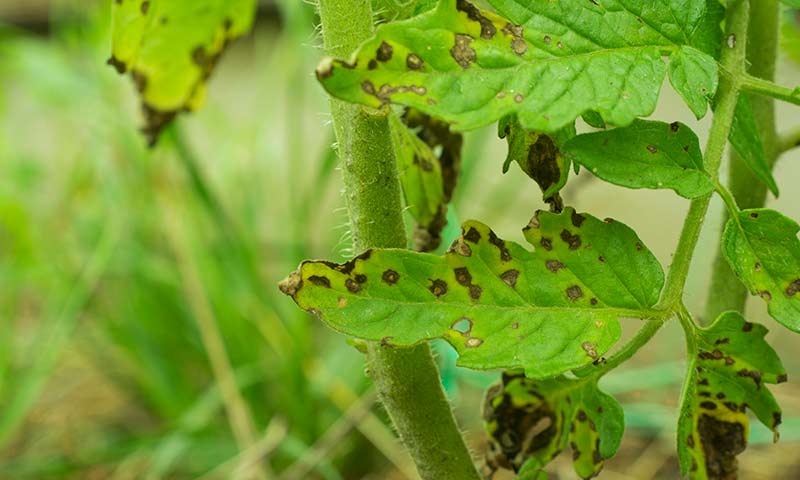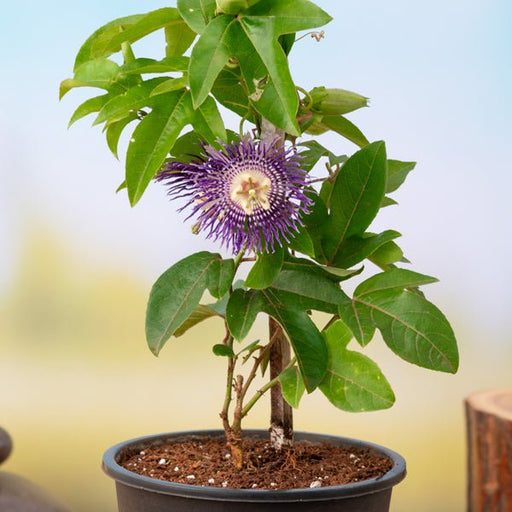
Available 24/7
Available 24/7

When your plants aren't at their best, it can be heartbreaking. Adding additional water or moving to a sunny location can sometimes help to restore plant health.
If that doesn't work after you've explored all other possibilities, it could indicate a larger problem. It's possible that your plant is infected.
Learn to spot signs and perform preventive to protect your plants from terrible diseases. Identifying the pathogen is the first step in a holistic strategy. Then choose a therapy method that is both safe and effective, as well as responsible.
To help you quickly detect and keep your plants looking fresh, we've put up a useful guide of the most common outdoor plant diseases you'll encounter below. So you'll know what to look for the next time you detect an unusual substance growing in the soil or an unique coloration on the leaf.

Leaf spots can affect a variety of plants, including flowers, vegetables, trees, shrubs, and herbs, due to warm air temperatures and rainy days. Bacteria or fungus, both of which can be found in soil or on neighbouring plants, cause leaf marks.
Warm air and rain create excellent circumstances for an outbreak, especially when leaves are wet 24 hours a day, seven days a week.
When an infected leaf falls to the ground, it rots slowly and infects the remaining of the plant. Any leaves that fall as a result of leaf spot illnesses should be collected and destroyed. To avoid leaf spot, cover the soil beneath the plants with mulch to prevent illness from splashing onto the leaves.
Many vegetables are affected by blossom end rot, including summer squash, tomato, eggplant, pepper, and cucumber. It's sometimes misdiagnosed as an illness by gardeners, but it's not.
It arises as a result of poor growing conditions, such as inconsistent watering and/or a lack of calcium.
However, blossom end rot frequently invites subsequent illnesses like as mould, which can quickly devastate the produce.
The simplest method for preventing blossom end rot is to add calcium to the soil at planting time.Use bone meal, gypsum, or oyster shells to fill in planting holes. Ensure that plants receive plenty of water during the growing season, and keep the soil moist by covering it with a thick layer of mulch.
High-nitrogen fertilisers should be avoided since they encourage rapid leaf and stem development while preventing roots from absorbing calcium.

Plant blight is a disease that affects a wide range of plants. In addition to potatoes, blight frequently affects other plants, particularly tomatoes. Blight is a fungal disease spread by spores carried by the wind.
As a result, spores can spread the virus swiftly across large areas. Blight can only spread in warm, humid circumstances, especially when temperatures are over 50°F. There is no cure. The only choice is to avoid it in the first place.
If you're planting potatoes, choose early types because blight strikes in the middle of the summer, and you'll be able to harvest your crop before the blight strikes. Maintain proper garden hygiene.
Rust is a fungus that causes rusty patches on leaves and stems. Although there are over 5,000 different varieties of rust, common rust affects a wide range of plants, including hollyhocks, roses, daylilies, snapdragons, lawn grass, and tomatoes.
It first shows as white dots on the bottoms of lower leaves. The patches turn reddish-orange and then black over time.
When a period of low light (4-8 hours), warm air, and moisture is followed by brilliant sunlight (8-16 hours), high temperatures, and high humidity, rust explodes. This combination of factors keeps leaves damp, allowing rust to thrive.
Because rust survives the winter on infected plants, it's critical to clean up and eliminate any contaminated plant portions to aid in disease control. Fungicides and copper or sulphur sprays can help to prevent and reduce the spread of rust.
Galls are enlarging lumps that grow on tree stems. They're unattractive, but they're not always a cause for concern. Trees with galls have a shorter lifespan, according to arborists, but this isn't a justification to cut them down.
Galls can be caused by a variety of factors. An injury to the tree can allow bacteria, fungus, or insects to enter the tree.
The tree reacts by isolating the invader, resulting in the formation of a gall. While a gall isn't a death sentence for a tree, it is a warning that it is hosting an unwelcome visitor.
To avoid spreading a microbe to healthy trees during trimming, clean cutting instruments after dealing with a gall-infected tree.
Many deciduous trees, herbaceous perennials, berries, and vegetables are affected by Verticilium Wilt, a deadly fungal disease. Flowering cherries are especially vulnerable. It penetrates the plant through the roots and moves upwards, clogging the plant's transportation system.
Young twigs and branches yellowing, wilting, and dying back, usually on one side of the plant or tree, are clear symptoms of a problem. Verticillium wilt gets worse every year.
Because there is no treatment once a plant is sick, all control is preventative. Remove any dead or dying plants, as well as infested roots and soil, and replace with tolerant or resistant species.
To avoid spreading the disease to non-infected trees, disinfect your pruning equipment between trees when pruning trees that may have this disease.
We normally recommend not planting the same species in an area that has been afflicted with Verticilium Wilt for several years after it has been infected.
We have just touched the tip of an ice berg in this article. One thing for sure, you need to take care of your plants.The stronger the plants are the better their immune system and capacity to fight illness is.
Plants that are weak and stressed are more likely to be attacked by diseases and pests.Take a look at your immune system. It will fight sickness better the better it is.
So take care good care of your plants and if you are in mess, hope this article helps.
 Sold out
Sold out
African Violets (Baby Pink) - Plant African Violets (Saintpaulia) are beloved houseplants known for their stunning, velvety leaves and vib...
View full details Sold out
Sold out
African Violets (Purple) - Plant African Violets (Saintpaulia) are enchanting houseplants known for their vibrant purple blooms and lush g...
View full details Sold out
Sold out
Aloe descoingsii - Succulent Plant Aloe descoingsii is a captivating succulent native to Madagascar, known for its striking rosettes and u...
View full details
 Save 25%
Save 25%
Angel Wing Begonia (Pink) - Plant The Angel Wing Begonia (Begonia coccinea) is a stunning houseplant known for its striking pink foliage a...
View full details
 Save 25%
Save 25%
Portulaca Double Mixed Color - Desi Flower Seeds Discover the vibrant beauty of Portulaca Double Mixed Color, a stunning collection of Des...
View full details
 Sold out
Sold out
Krishna Kamal, Passion Flower, Passiflora incarnata (Purple) - Plant The Krishna Kamal, also known as the Purple Passion Flower, is a stunning per...
View full details
 Save 25%
Save 25%
Ridge Gourd Jaipur Long - Desi Vegetable Seeds The Ridge Gourd Jaipur Long, also known as 'Turai' or 'Tori', is a cherished desi vegetable...
View full details
 Save 20%
Save 20%
Clitoria Ternatea, Gokarna (Blue) - Plant Discover the enchanting Clitoria Ternatea, commonly known as Gokarna or Butterfly Pea, a stunnin...
View full details
 Save up to 15%
Save up to 15%
Peace Lily, Spathiphyllum - Plant The Peace Lily, scientifically known as Spathiphyllum, is a stunning houseplant celebrated for its elegant white...
View full details
 Save 18%
Save 18%
Combo Constituents Includes the Parijat Tree (Night-Flowering Jasmine), a culturally significant plant with fragrant flowers. Description The Pari...
View full details
 Save 25%
Save 25%
Description Raat Ki Rani (*Cestrum nocturnum*), also known as Night Blooming Jasmine, is a fragrant shrub native to the Caribbean and Central Ameri...
View full details
 Save 25%
Save 25%
Jasminum sambac, Mogra, Arabian Jasmine - Plant Jasminum sambac, commonly known as Mogra or Arabian Jasmine, is a fragrant flowering plant...
View full details
 Save 17%
Save 17%
Rajnigandha, Tuberose - Plant The Rajnigandha, scientifically known as Polianthes tuberosa, is a captivating perennial plant renowned for ...
View full details
 Sold out
Sold out
Citronella, Odomas - Plant The Citronella plant, scientifically known as Cymbopogon nardus, is a tropical grass renowned for its aromatic ...
View full details Save 25%
Save 25%
Damascus Rose, Scented Rose (Any Color) - Plant The Damascus Rose, also known as Rosa damascena, is a timeless symbol of beauty and romanc...
View full details
 Save 35%
Save 35%
Best 6 Plants for Perfect Indoor Garden Transform your living space into a lush oasis with our curated collection of the Best 6 Plants for a...
View full details
 Save up to 50%
Save up to 50%
Mini Succulent Garden Pack Transform your space with our Mini Succulent Garden Pack, featuring a delightful collection of 4 any variety beautiful s...
View full details
 Save 30%
Save 30%
5 Best Fragrant Plants Transform your garden or indoor space into a fragrant paradise with our curated selection of the 5 Best Fragrant Plants. Th...
View full details
 Save 24%
Save 24%
Set of 2 Bonsai Looking Grafted Adeniums Transform your indoor or outdoor space with our exquisite Set of 2 Bonsai Looking Grafted Adenium...
View full details Save 45%
Save 45%
Top 4 Die Hard Succulents Pack Transform your indoor or outdoor space with our Top 4 Die Hard Succulents Pack, featuring a curated selecti...
View full details
 Save 30%
Save 30%
5 Best Indoor Plants Pack Transform your living space into a lush oasis with our '5 Best Indoor Plants Pack.' This carefully curated collection fe...
View full details
 Save 25%
Save 25%
Set of 4 Evergreen Air Purifier Plant Pack Transform your indoor space into a lush, green oasis with our Set of 4 Evergreen Air Purifier Pla...
View full details
Comments
Leave a comment